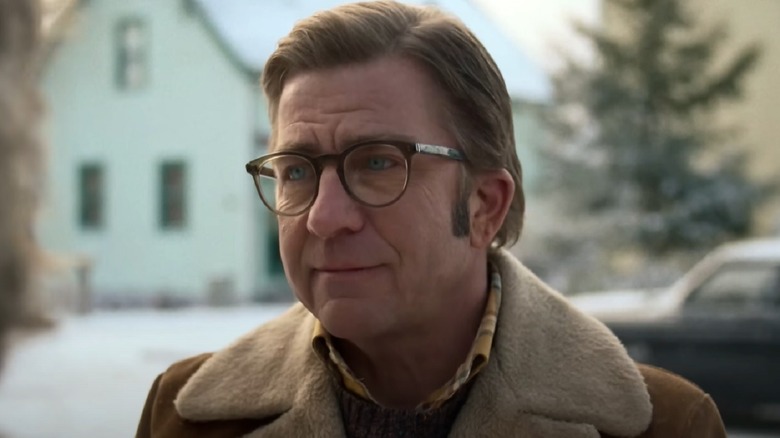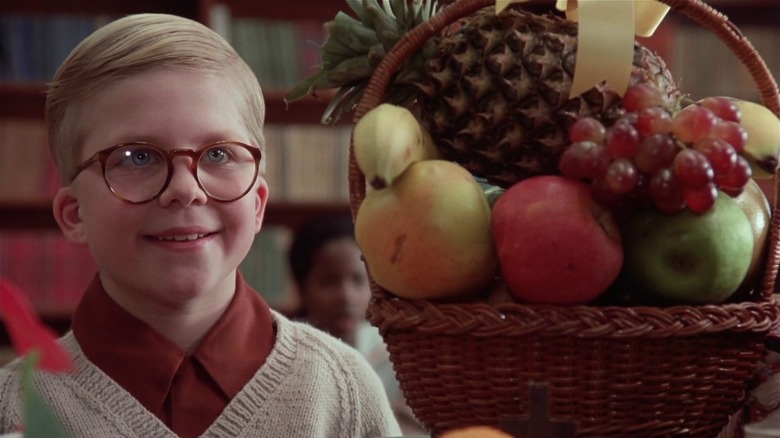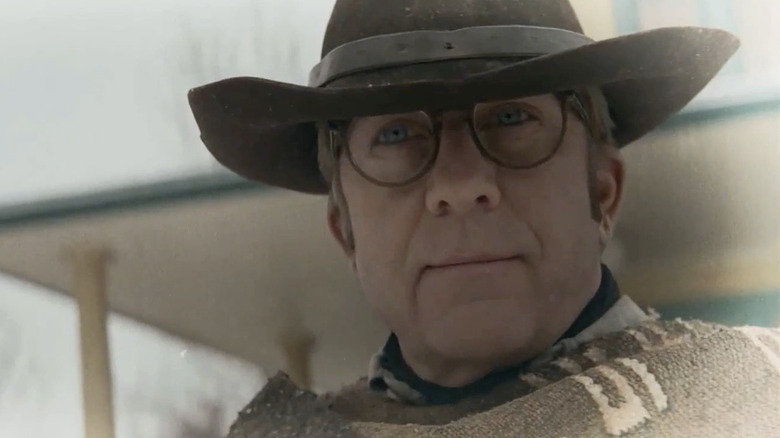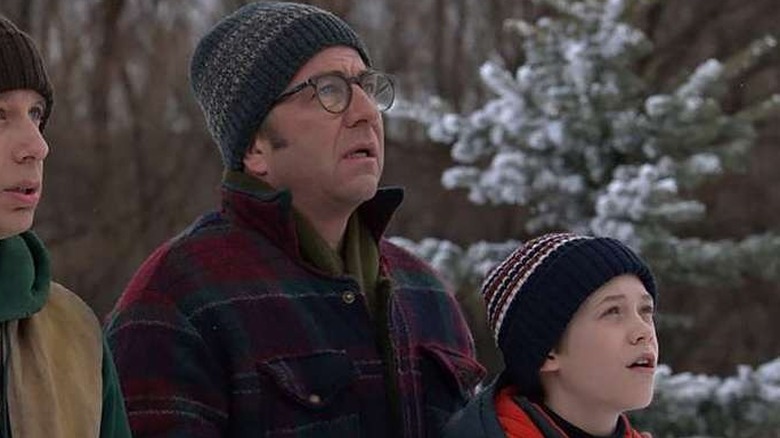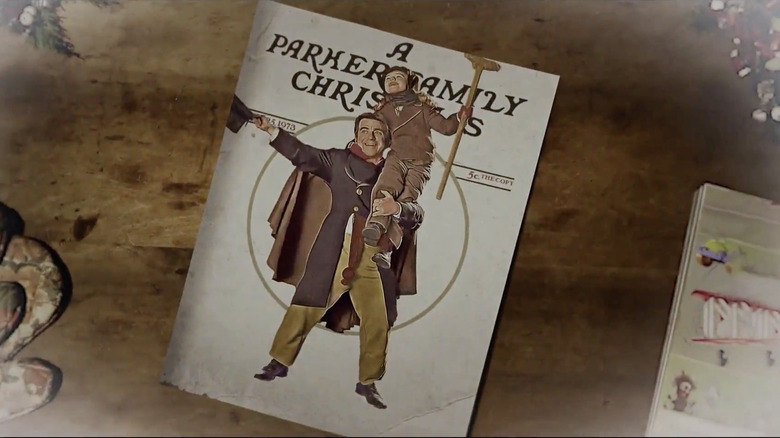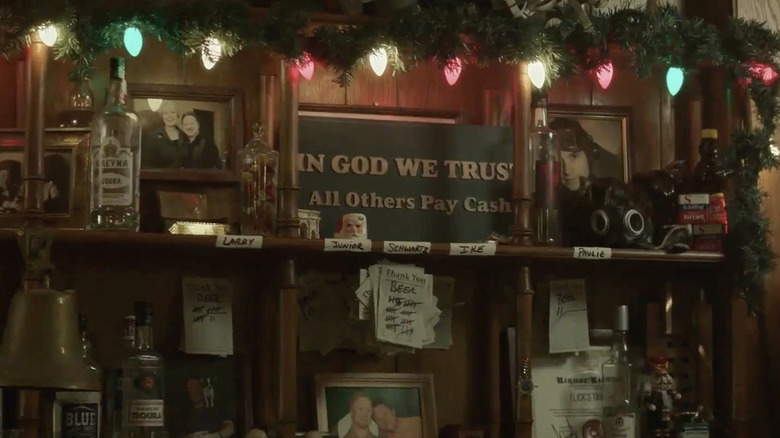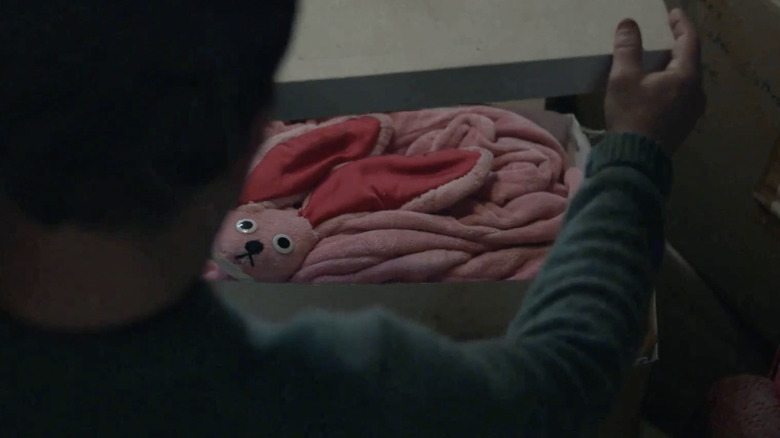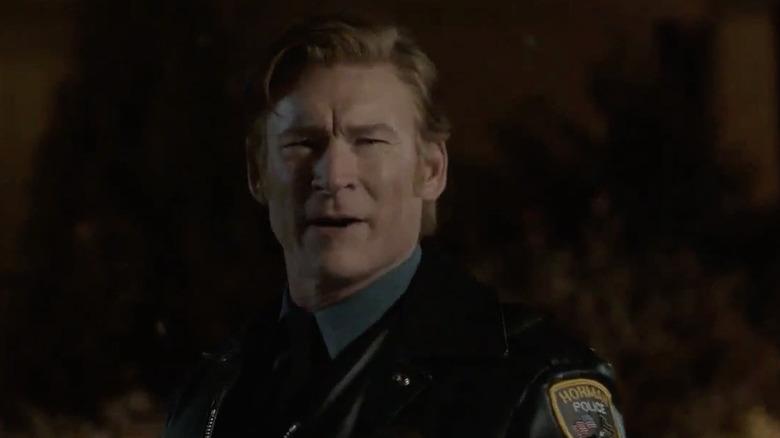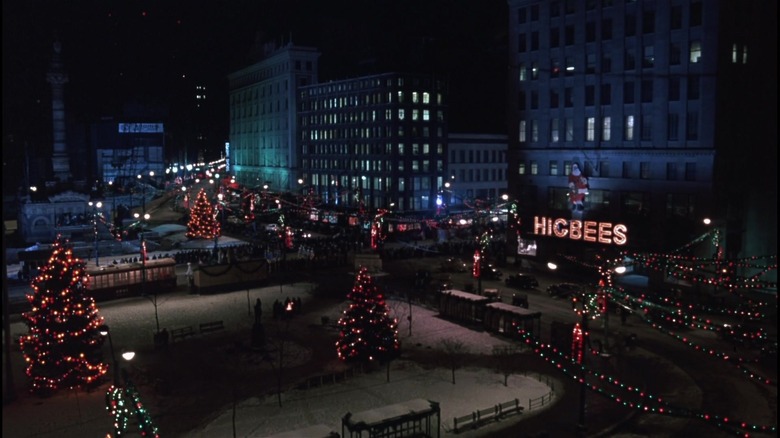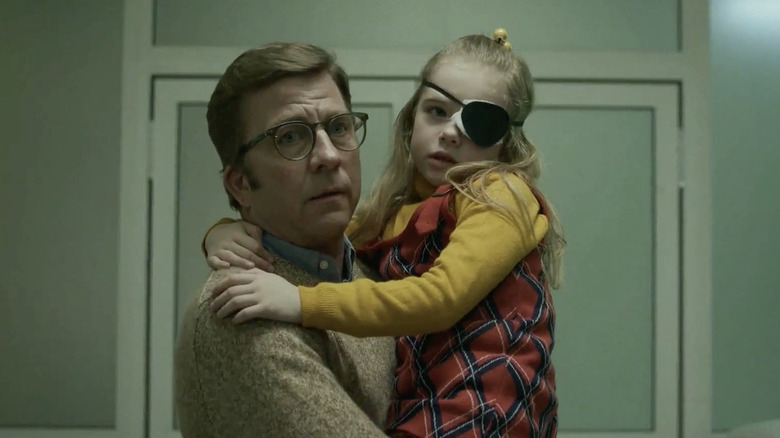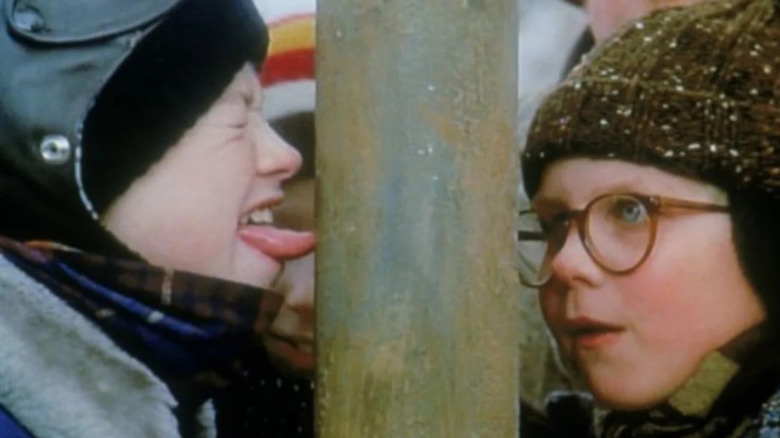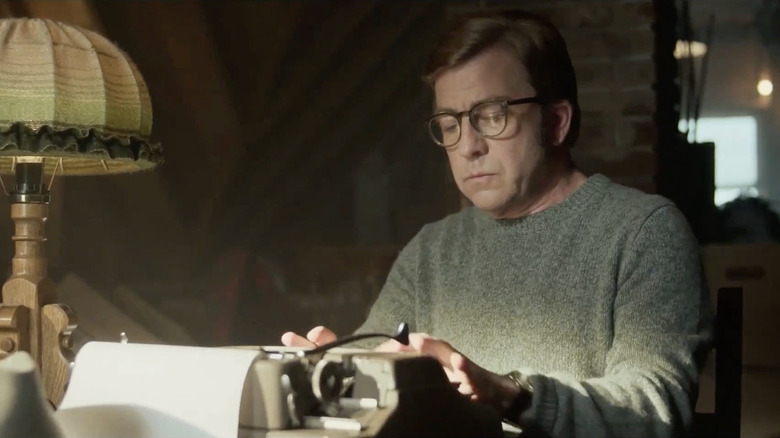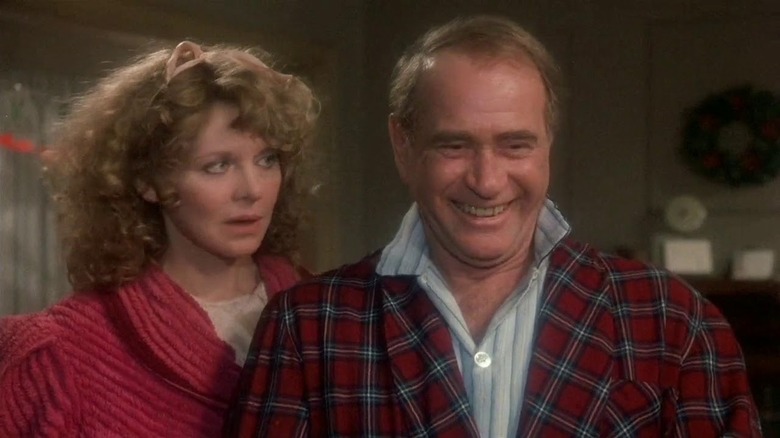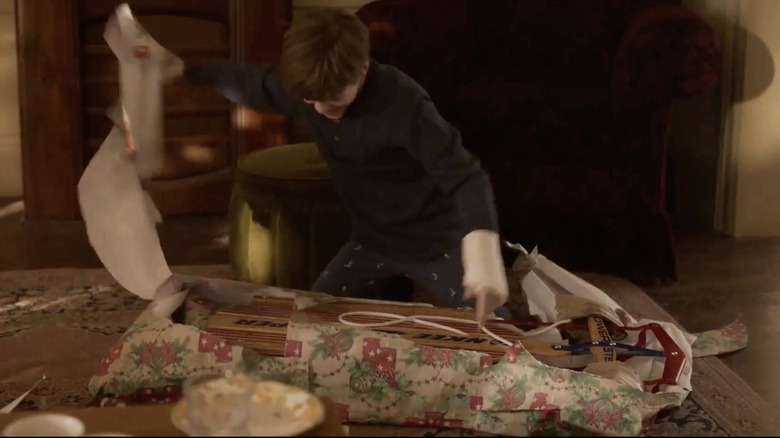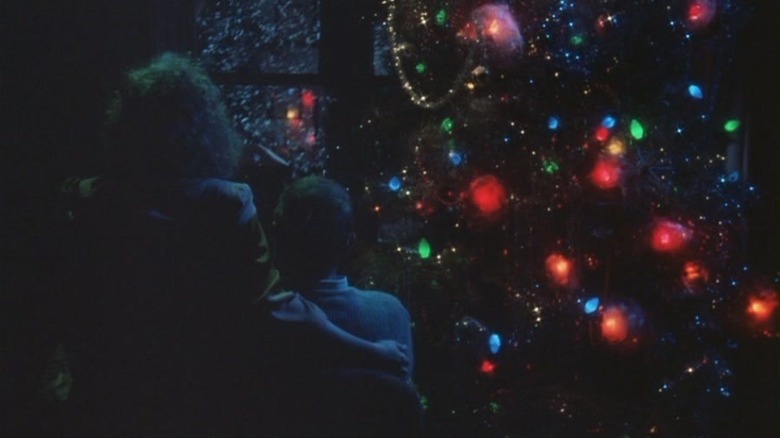Small Details You Missed In A Christmas Story Christmas
Christmas movies can be divided into two groups: the classics and everything else. And when it comes to classics (especially "modern classics"), few can rival "A Christmas Story." Its ability to capture the angst, fun, and frustration of the holidays, especially through the eyes of a child, is nearly unrivaled. If anything the biggest complaint people might have is that they've seen it so many times it's become blasé (no doubt in part because TBS airs it for 24 hours every Christmas).
For that reason, you'd be hard-pressed to find somebody who doesn't have its famous lines tattooed onto their brain ("You'll shoot your eye out" and "Fra-jil-E" are practically universal quotes by now). Its longstanding status as the gold standard makes "A Christmas Story" such a vehicle for nostalgia junkies everywhere that few Christmas fans can think about the season without flashing to memories of Ralphie's epic pursuit of a Daisy Red Ryder BB gun. This is why HBO's sequel, "A Christmas Story Christmas," starring a grown Ralphie struggling to recreate the perfect Christmas for his own children, is guaranteed to elicit all the feels for any Christmasphile.
Even more, this holiday season you won't have to rewatch the original for the 40th (or 300th) time to get that mix of throwback humor, wonder, and satire that made the original so indelible. Though you probably will. Especially given all the little details, the Easter eggs, and references in "A Christmas Story Christmas" that you might miss if you don't have the original committed to memory.
Ralphie is still bribing people to like his writing
In "A Christmas Story," Ralphie thinks the way to get his parents to grant his wish of getting a Daisy Red Ryder BB gun is by writing an A+ essay about why it's the perfect gift. While he thinks his writing is strong, Ralphie also knows a bribe won't hurt. So while other kids get their teacher an apple, he gets her a fruit basket.
In the new movie, "A Christmas Story Christmas," Ralphie is a struggling novelist. In his meeting with a publisher, he gives the publisher some candy that he admits is a bribe in his internal monologue. He even asks his manager later if the other publisher he was hoping would buy his book got the fruit basket he sent. As was the case back then, the bribes don't work. In the case of the publisher we see, the bribe just goes in the drawer with the other bribes in a shot similar to the one showing Ralphie's teacher had a similar drawer she puts her students' pranks in.
He still has over-the-top dreams
In "A Christmas Story," Ralphie has a lot of dreams about the future. His paper is such a success that his teacher raves about it and his classmates loft him on their shoulders as a great hero. On the other side, Ralphie sees a future where he goes blind because his mom punishes him by forcing him to put soap in his mouth.
In "A Christmas Story Christmas," Ralph sees a future where he wins a major literary award to the chagrin of the publisher who rejected him. And he sees a future where his Christmas Eve arrest turns his daughter into a teen mom and his son into a member of the Sex Pistols.
Then there's the Black Bart dream. In the original movie, young Ralphie saves everybody with his BB gun and Black Bart threatens to come back. In the new movie, Ralph takes on a Clint Eastwood vibe but can't save his family. In trying to protect them, he made them weak and falls in battle. Black Bart says they'll come back but Ralphie won't be there to protect the kids and wife. As an optimistic child, he's a hero; as a struggling grown-up, he fails.
He's different from Old Man Parker
"Some men are Baptists, others are Catholics, my father was an Oldsmobile man," Ralphie says in "A Christmas Story." In "A Christmas Story Christmas," Ralph drives an old Plymouth. Even more, his car is pretty beat-up while his Old Man had seen himself as a member of the pit crew in the Indy 500.
While there are some similarities, the differences seem to be more prevalent. There's the scene where adult Ralphie goes to buy a tree, attempting to emulate his Old Man's ability to negotiate the best price. Instead of getting a great deal, he accidentally buys the monster tree that the lot couldn't sell. Even more, while his dad is a model of 1940s middle-class success (the main breadwinner while the mom is a homemaker), Ralph is a struggling writer whose wife is supporting the family. Though many would say that's actually a sign of progress from the world of housewives and workingmen the original movie inhabits.
One thing stays the same, though: Ralphie is as devoted to his kids as the Old Man was.
The Rockwell-esque magazine images in his dream
In "A Christmas Story Christmas," Ralphie has a daydream remembering all the perfect Christmases his Old Man presided over. They're basically a series of images of the family presented in Norman Rockwell-esque illustrations. Most are actually just recreations of Rockwell classics (like the opener, a redo of the famous Tiny Tim Saturday Evening Post cover). The montage is fleeting but important as it brings to mind the idea of living up to the old American Christmas dream. It also harkens to the look of the original poster.
The poster for "A Christmas Story" was illustrated by Robert Tanenbaum yet looked like one of Norman Rockwell's classic depictions of Americana. The 2012 sequel "A Christmas Story 2" also had a Rockwellian poster. It is appropriate that a movie that has had such a profound impact on American cinematic culture set during the heyday of "The Greatest Generation" adopted a Norman Rockwell aesthetic in its promotions. Even more, it's fitting that Ralph's daunting attempt to encapsulate and recreate these moments was referenced through these classic illustrations.
Ralphie and his dad both want practical gifts centered on heat management
Once you're a parent, people are considerably less interested in what you want for Christmas. Maybe that's because what you want as you get older is often less fun than the hottest new toy. In "A Christmas Story," the Old Man says he wants a new furnace for Christmas. Several times we see the Old Man head to the basement to fight their furnace with a string of expletives and the sound of clanging echoing through the house.
In "A Christmas Story Christmas," Ralph starts off by asking for his dream gift — a time machine to go back to the beginning of the year when he and his wife had agreed he could have a year to pursue his writing career full-time. Then he mentions the more realistic gift: He wants a new radiator for his car. We see Ralph's Plymouth's constant radiator issues (which he fixes with an egg and one time he just has to wait for it to cool down). So maybe Ralphie and his Old Man are more alike than they thought. They both have trouble with heat-regulating machines.
In God We Trust -- All Others Pay Cash
When Ralphie walks into Flick's pub, there's a sign behind the bar that says "In God We Trust — All Others Pay Cash." You might not even have noticed it, but there's a great amount of relevance there. This is more than just a clever turn of phrase perfect for a drinking establishment full of barflies. It's also where "A Christmas Story" came from.
Jean Shepherd was a noted writer and radio voice who most notably penned a series of stories inspired by his youth entitled, you guessed it, "In God We Trust — All Others Pay Cash." It's about an assignment to write about the small town where he came from (in the book, Shepherd is living in NYC, not Chicago). In the book, he starts off reciting all he hates about his hometown (which the children discuss at the beginning of "A Christmas Story Christmas"). Then he stops in the bar owned by his childhood friend Flick and begins reminiscing. The first story is about that one Christmas when all he wanted was a Red Ryder BB gun...
The attic of memories
In "A Christmas Story Christmas," Ralphie returns to his childhood home for a Christmas unlike any other because it will be Ralphie's first Christmas without his Old Man. The home looks the same, sure, but it's in the attic where we find the real treasures.
Ralph goes up to the attic looking for the Christmas ornaments and as is often the case, the man is thrown back into his old childhood digging through his parents' "junk." He opens a box and finds the pink bunny costume that we had seen him receive in "A Christmas Story," a gift from Aunt Clara his mother found delightful and his father had said looked like a "deranged Easter Bunny."
He sees the lampshade, all that was left from his father's infamous leg lamp (which his mother "accidentally" breaks in "A Christmas Story"). He sees his great Red Ryder air gun. He sees the blue bowling ball his mom had gotten for the Old Man for Christmas — and then carelessly dropped onto his crotch. And then he gets infuriated when he finds a plastic Christmas tree his mother had bought. She explains his father had rejected it, of course, and in that spirit decides the first thing to do is to go get a Christmas tree. There is some irony in the fact that the Old Man had said he was thinking of maybe buying a plastic tree as a way to negotiate the Christmas tree salesman into throwing in a piece of rope and tying the tree onto the Old Man's Oldsmobile.
Same but different
As Mark Twain once said, "History never repeats itself, but it does often rhyme." And "A Christmas Story Christmas" is full of rhyming. We see the same radio Ralphie used to listen to (how it survived 30 years...) but it's next to a TV. The hole in the fence now has a flapping door. Then there is the Bumpus family.
In "A Christmas Story" we only ever see the Bumpus hounds. They swarm the Old Man, and they irritate him to no end, though the coup de grace is when they eat his Christmas Turkey. The Bumpus family still has a ton of hounds who now swarm Ralphie. But for the first time, we see an actual Bumpus — Delbert.
Ironically, Delbert Bumpus ends up being the key to Julie getting her dad Ralphie the gift he wants, though his father (or the memories of his father) gives him the other gift he wants. His dad helps him become a published author. But Delbert Bumpus delivers a radiator.
One final rhyme is the fact that the two bullies are the sons of Scut Farkus (and Ralphie's children stand up to them as Ralphie did to their father). The twist: Scut is now a cop and ends up actually being somewhat of a saving grace for an adult Ralphie.
Higbees is also the same, but different
Hohman is a fictitious midwestern city, a mill town it would seem, set up to represent Anytown, USA. The central part of Hohman is of course the great department store downtown, Higbees. In "A Christmas Story" young Ralph describes reveling at the window and in "A Christmas Story Christmas," he's still just as impressed.
When they go in the elves have the same costume. The setup has a slide down from Santa, to the point that Ralph warns his children about getting a boot in the face as he had in "A Christmas Story." And Santa is a distraction for the kids while their parents shop. There's even a creepy kid in front of the children in line who blows up when it's finally his turn to talk to Santa.
There are differences, though. Mom and Grandma sit in the lounge drinking while Dad does all the shopping. Julie is a shrewd negotiator with Santa, unlike her father. And this time around, we get to see the mad dash of pre-internet gift shopping that today is relegated to Gen X and older nostalgia.
Ralphie shoots Julie's eye out (almost)
There are few more memorable lines from any Christmas movie ever than "You'll shoot your eye out" from "A Christmas Story." Ralphie's mom says it; his teacher says it; the Higbee's Santa says it to him. This simple but famous line was the top reason everybody gives for him not to get a BB gun. And sure enough, the first time he shoots the rifle a BB ricochets into his glasses. Since his glasses saved him, though, there are no eye injuries in his family. That is until he pegs his daughter.
In "A Christmas Story Christmas," the scene that most cements Ralph's role as a good dad is not the gift-hunting or the desire to make them stronger or deliver the perfect Christmas. We see him launch into an unabashedly joyous snowball fight with his kids as his car cools down and we instantly realize how much he loves his family. All is going well until Ralph turns to launch a distant snowball at his son Mark and inadvertently hits his daughter Julie in the eye at point-blank range. She ends up with an eye patch. And Ralphie almost actually shoots somebody's eye out.
Flick's revenge
The inclusion of a grown Flick and Schwartz in "A Christmas Story Christmas" was a highlight for anybody who grew up with the movie and wondered whatever happened to their own childhood friends. Of course, in the original film, you'd maybe only know them as Ralphie's friend who stuck his tongue to a pole (Flick) and the one who triple-dog-dared him (Schwartz).
These days, Flick owns the bar where Schwartz is a barfly. One of the most memorable moments in the first movie is when Flick sticks his tongue to a pole and gets it stuck, eventually having to be unstuck by the fire department. You can't help but feel bad for Flick and so it's a wonderful moment to see him get his revenge in "A Christmas Story Christmas." In the new film, he triple dog dares Schwartz to hit a frozen slide and jump into a snowy field. Schwartz gets his comeuppance, and like all good friends, they follow it with some "all-is-forgiven" camaraderie.
Ralph's writing flow
It seems like an odd choice to have Ralphie grow up to be a writer (besides the fact that it was created by a writer). But in "A Christmas Story," he does have a scene of divine inspiration. While writing his essay on why he should get a Daisy Red Ryder BB Gun, Ralphie describes the words just flowing out of him into what would no doubt be a magnificent treatise.
In "A Christmas Story Christmas" grownup Ralph goes to the attic, now having failed to get his book published, get the kids presents, or even in his eyes to have stepped into his Old Man's large shoes. He describes how the words flow through him as he writes about his old man for what was supposed to be his dad's eulogy.
In "A Christmas Story," the essay doesn't get the grade or reaction he'd hoped. Yet, in "A Christmas Story Christmas," this flow of inspiration yields a story so captivating that it lands on the front page of the local paper and even syndication.
Escape music and shots
Some of the most memorable "fancy" shots in "A Christmas Story" involve a riveting chase score and some sped-up shots and audio, especially while running from the bullies. While "A Christmas Story Christmas" has some special effects ranging from the aforementioned Rockwell montage to a boy who throws up at Santa's feet, the original "A Christmas Story" depended more on the actors and Jean Shepherd's narration to invoke emotion. Still few moments better show the feeling of a hurry than the moment when everything frantically speeds up.
In "A Christmas Story Christmas," this effect isn't used to show them running from a bully. It's used to show how excited they are to see Flick's revenge. The bar clears out at record speed as everybody. No longer are they using speed to run from bullies but to run to drunken antics. I guess that's growing up.
Even more, Scut the bully evokes the song of the wolf from "Peter and the Wolf," both then and now. Symphonic themes always do a great job of really tying time together.
Dad saves Christmas in both
In "A Christmas Story," the only gift Ralphie truly wants is the one present nobody wants to give him. He even opens all his presents on Christmas day and while he's grateful, he admits he didn't get everything he wanted. Then the Old Man tells him to check the box behind the desk and there it is: Ralph's Daisy Red Ryder BB Gun. When Mother looks at him, the Old Man explains he had one himself when he was 8. Though the smile as Ralphie opens it says everything: The man lived for his kids' holiday happiness.
In "A Christmas Story Christmas," all of the presents get stolen from the broken trunk of Ralph's beater car. On Christmas Eve, Mother goes to the basement only to find that the Old Man had actually purchased all of the gifts the kids wanted and so they get the Christmas they wanted despite heading into Christmas Eve without many prospects for gift exchanging. Not only does Pops get all the gifts, but in writing about him Ralph finally gets his first published success.
When Mark unwraps the sled he'd wanted and in ecstatic incredulousness asks how the Old Man knew it was what he wanted, Ralphie says, "He knows. He always knows." Which was the Old Man's answer when Ralphie told him Santa didn't ask whether he had been good or bad.
Kids still open presents the same
There is a time-honored tradition of children running through the meticulously-wrapped gifts they've received. The Parkers are no different. What is fun to see, though, is how similar Mark and Julie are to Ralph and Randy when they were kids. The chaos that is Christmas gift-opening was captured perfectly in "A Christmas Story," and the echoes in "A Christmas Story Christmas" hit just as hard.
It starts off controlled and respectful but then it quickly explodes into an all-out bacchanalia of ripping wrapping paper. Even more, in "A Christmas Story," Ralph and Randy both open socks at the same time. They look at their boring gifts, then disinterestedly throw the socks over their shoulders and get back into tearing. In "A Christmas Story Christmas," Mark and Julie get books (they look to be dime-store pulp novels) and throw those over their shoulders before getting back to work. Proving whether we're talking about the 1940s or the 1970s, one thing remains the same: Kids have no problem running through their gifts in search of the ones they actually like.
The Christmas tree in the dark scene returns
There's a lot to relate to in "A Christmas Story." But few parents can deny that possibly the best scene is when Mother and the Old Man get to sit in a chair together, in the dark, having successfully pulled off yet another Christmas, staring out the window, in peaceful triumph. "A Christmas Story Christmas" has its own version of the scene but it's a little different. The Old Man is gone. Or is he?
Yes, now instead of him and Mother basking in the glow of the tree after all the chaos of the holiday it's Mother and Ralphie, worried about the future and missing the Old Man. Yet the simple beauty of that scene is still there. Then the fuse blows, another of The Old Man's love-hates because it allowed him to show off his handiness despite it being a pain. And of course, just when Mother and Ralphie bring the Old Man up, the fuse blows. If anything, this scene, like so many others, shows that the traditions we honor and the memories we make with our families, especially around the holidays, continue on long after we pass on.
